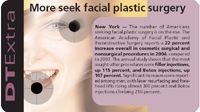- Case-Based Roundtable
- General Dermatology
- Eczema
- Chronic Hand Eczema
- Alopecia
- Aesthetics
- Vitiligo
- COVID-19
- Actinic Keratosis
- Precision Medicine and Biologics
- Rare Disease
- Wound Care
- Rosacea
- Psoriasis
- Psoriatic Arthritis
- Atopic Dermatitis
- Melasma
- NP and PA
- Skin Cancer
- Hidradenitis Suppurativa
- Drug Watch
- Pigmentary Disorders
- Acne
- Pediatric Dermatology
- Practice Management
- Prurigo Nodularis
- Buy-and-Bill
Article
Derm Surgeons adapt to upswing in new cosmetic procedures
New Orleans — Non-melanoma skin cancer surgery is still the most common procedure performed by dermatologic surgeons, and they treat the vast majority of skin cancers. But over the past couple of years, cosmetic procedures have increased in popularity, particularly noninvasive procedures, such as nonablative lasers, fillers and botulinum toxin.

Thomas Rohrer, M.D., SkinCare Physicians of Chestnut Hill, Mass., and associate professor of dermatology, Boston University, says new laser and light devices and techniques are being introduced almost every month. He says the new technologies are evolving in ways that provide better results with less downtime for the patients.
Dr. Rohrer says these changes come as society moves in the direction of looking for more subtle changes in their approach to cosmetic surgery.
At the 63rd Annual Meeting of the American Academy of Dermatology (AAD), Dr. Rohrer outlined a number of updated techniques that are particularly suited to fill that niche.

With Fraxel resurfacing, small columns of the skin are heated and the collagen is denatured down to about 300-600 microns.
"The majority of the surrounding skin is left completely untouched. This allows the skin to heal in from the sides rather than only from underneath. It heals very, very quickly and there is no significant downtime," he says.
Dr. Rohrer adds the only downside is that because the entire area is not treated at one time, so the results are initially "very subtle."
"The procedure requires multiple treatments repeated about every two to four weeks. By performing multiple treatments over the area, you can cover the majority of the surface - and get very impressive results without the downtime." The results are cumulative and the cost will probably be similar to the overall price of a regular full-face resurfacing procedure.
Lasers for acne "The hope is that we can shrink the sebaceous glands with heat, and, probably more importantly, straighten out the infra-infundibulum. That will allow the sebum to escape more easily."
Laser treatments can provide long-term improvement in acne, not just a short-lived response. A number of different light sources and lasers have been used to treat acne, but the ones that target the sebaceous gland have been shown to be most effective, according to Dr. Rohrer.
He says that approximately 70 percent of patients who failed topical and multiple oral medications are responding very nicely to the lasers. The lasers appear to work on both comedonal and nodular cystic acne.
"An added benefit is that these are the same lasers used to treat acne scarring, so patients with active acne and acne scars get a two-for-one benefit. And if the patient happens to be old enough to need it, these same machines are also effective for treating wrinkles."
Infrared lasers are the most common choice for acne, but radiofrequency devices and multiple laser and light sources using photodynamic therapy are also being used effectively.
Lasers are not a first-line treatment for the average patient unless a person has acne scarring as well as active acne and wants to improve the acne scars. Typically, dermatologists will first try topical medications and a variety of oral medications, antibiotics and potentially Accutane (Roche).
Combining fillers, Botox Multiple modalities are being used to optimize results and get the most natural-appearing cosmetic results.





